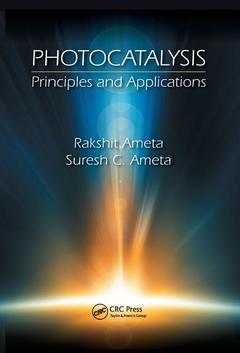Photocatalysis Principles and Applications
Auteurs : Ameta Rakshit, Ameta Suresh C.

Photocatalysis, reactions carried out in the presence of a semiconductor and light, is rapidly becoming one of the most active areas of chemical research, with applications in areas such as electrochemistry, medicine, and environmental chemistry, Photocatalysis: Principles and Applications stresses the development of various types of photocatalytic semiconductors, including binary, ternary, quaternary, and composite, and their modifications by metallization, sensitization, and doping to enhance their photocatalytic activities. In addition to describing the principles and mechanisms of photocatalysis, it also discusses other possible applications of photocatalysis such as use as antifouling agents, controlling air pollution by degrading contaminants present in the environment, self-cleaning of glasses and tiles in the presence of light/artificial light, green composites, wastewater treatment, hydrogen generation, and inactivation of microorganisms. The book also describes medical applications and summarizes efforts in the field of photosplitting of water as a newer energy source and photoreduction of carbon dioxide for providing synthetic fuels and also a step towards mimicking photosynthesis.
- Introduces the basic principle of photocatalysis.
- Provides an overview of the types of semiconductors, their immobilization, and modifications to make them more active.
- Gives possible applications of photocatalysis in wastewater treatment and strategy to combat against different kinds of pollutions like water, air, and soil.
- Summarizes efforts in the field of photosplitting of water as a newer energy source and photoreduction of carbon dioxide for providing synthetic fuels and as a step towards mimicking photosynthesis.
- Discusses inactivation of different kinds of microorganisms.
- Covers medical applications.
Contents
1. Introduction
2. Photocatalysis
3. Binary semiconductors
4. Ternary semiconductors
5. Quaternary semiconductors
6. Metallization
7. Doping
8. Sensitization
9. Composites
10. Immobilization
11. Hydrogen generation
12. Solar Cells
13. Waste water treatment
14. Reduction of carbon dioxide
15. Artificial photosynthesis
16. Medical applications
17. Other applications
18. Inactivation of microorganisms
19. Photoreactors
20. Future trends
Rakshit Ameta obtained his Master of Science degree with first position and was awarded Gold Medal. He received the Fateh Singh Award from the Maharana Mewar Foundation for his meritorious performance. He has worked at M. L. Sukhadia University, University of Kota and presently is an Associate Professor of Chemistry at PAHER University. Widely published, Dr. Ameta has been elected as Scientist-in-Charge, Industrial and Applied Chemistry Section, Indian Chemical Society (2014–2016), and was also elected as a Council Member of the Indian Chemical Society (2011–2013) and the Indian Council of Chemists (2012–2015).
Suresh C. Ameta obtained his Master’s degree and was awarded Gold Medal in 1970. He secured a first position in M. Phil. in 1978, and Ph.D. in 1980 from Vikram University. He served as Professor and Head, Department of Chemistry, North Gujarat University Patan (1994) and M. L. Sukhadia University (2002–2005), and as Head, Department of Polymer Science (2005–2008). He also served as Dean, Post Graduate Studies, M. L. Sukhadia University (2004–2008). Now he is Dean, Faculty of Science, at PAHER University. He had been President of Indian Chemical Society (2000–2001). Widely published and highly decorated, Professor Ameta has approximately 43 years of experience in teaching and research.
Date de parution : 12-2019
15.6x23.4 cm
Date de parution : 11-2016
15.6x23.4 cm
Thèmes de Photocatalysis :
Mots-clés :
Photocatalytic Activity; Visible Light Irradiation; photoreduction; Photocatalytic Degradation; photosplitting of water; Water Splitting; photocatalysts; Hydrogen Production; composite photocatalysts; Energy Source; binary semiconductors; High Photocatalytic Activity; ternary semiconductors; Band Gap; metallization; Photocatalytic Water Splitting; doping; UV Irradiation; quarternary semiconductors; Photocatalytic H2 Production; sensitization; Photocatalytic Reduction; immobilization; Reactive Black; hydrogen generation; H2 Evolution Rate; solar cells; Photocatalytic Hydrogen Production; wastewater treatment; Pseudo-rst Order Kinetics; reduction of carbon dioxide; Photocatalytic CO2 Reduction; artificial photosynthesis; Degussa P25; photoreactors; TiO2 Nanoparticles; PEC; H2 Production; High H2 Production Rate; Higher Photocatalytic; TiO2 Lm



